Everyday Teas approach is carrying quality daily drinker teas. The owner is passionate about puer, so in their line up including a number of raw puer cakes! Everyday Teas awesomely sent me one of each of their 2016 and 2017 puer cakes. I thought I’d blind taste them at once to remove the bias of which one I would like (likely the Nannuo) as well as tasting perceptions I have of each region. Every person I know who has done a blind puer regional tasting has told me that everyone guesses wrong, which adds some reassurance in the event I fail.
For today’s tasting, we have a Nannuo Shan, Ailao shan, and Bulang Shan, all 2016 teas.

2016 Sheng Puer Regional Blind Tasting Method
I numbered the bottom of each gaiwan saucer. I then cut a ratio of 1 gram/ 15ml out of each cake, placed the teas in order of my key, and got my husband to mixed up the gaiwan sets without me looking. My answer key is = 1. Nannuo shan, 2. Ailao shan, 3. Bulang shan. For the reviews, I am working LEFT to RIGHT. I also ate a ham sandwich and some cookies beforehand to hopefully limit the gut rot.
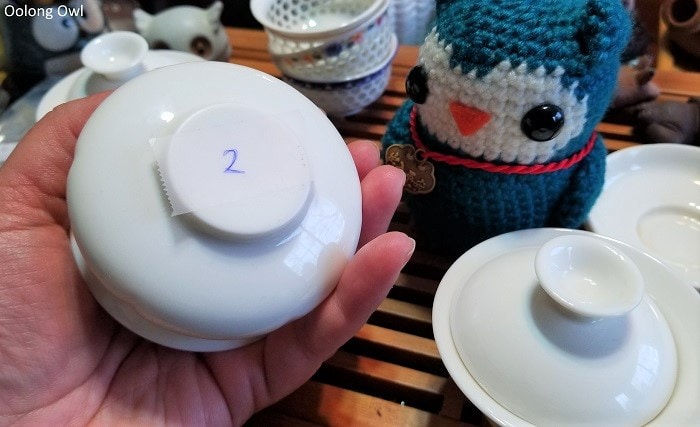
I tried to not smell the dry leaf to not give it away, but dang that Bulang was pungent AF when I was breaking it. The Nannuo looked quite pretty.
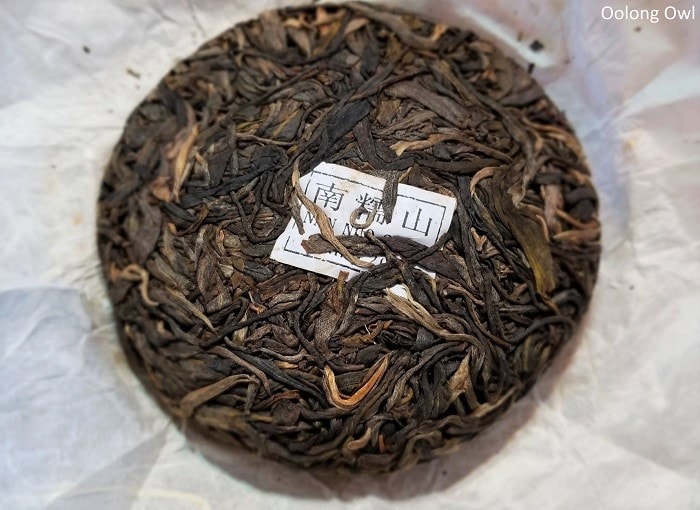
I steeped all teas in boiling water and ended up doing 7 infusions.
2016 Sheng Puer Regional Blind Tasting
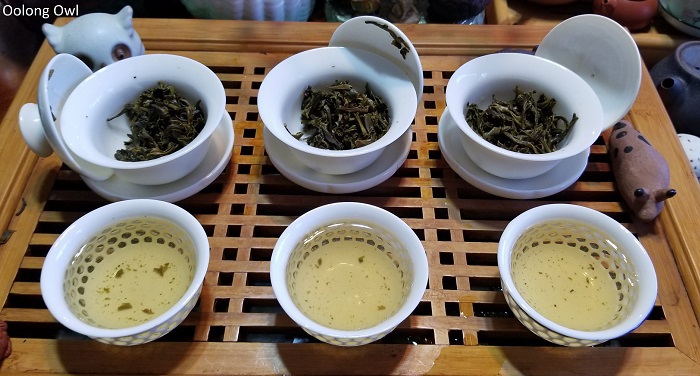
Left Gaiwan – The hot leaf is pungent, very strong, and almost smokey.
The Left Gaiwan tea has savory mineral notes leaning salty. As it went on the steeping of pungent. It is bitter (but good bitter), eye-popping, and teeth gritty numbing with a mineral tang aftertaste. The body is nicely thick feeling. The pungency has a bit of pucker to it to the point I am not sure what I am tasting other than bitterness and gut-punching. My cheeks feel dry and numb but I get an interesting floral acid aftertaste.
The final infusions of this were quite nice. It was bitter, but not soul-crushing death like Middle Gaiwan. The lightly fruity aftertaste contrast with the bitter keeps this tea going and interesting.
This tea is an ugly duckling. It starts bitter and likely will make some tea drinkers dump and run. This one teaches there is good and bad bitter if you look deeper into it. The longer you stick with this tea, you notice a break in bitterness in the aftertaste, as well as it resteeps better and the bitterness chills out in later infusions. This one certainly is more bang for your buck in resteeps. I could have gone another 2 or 3 more than the rest.
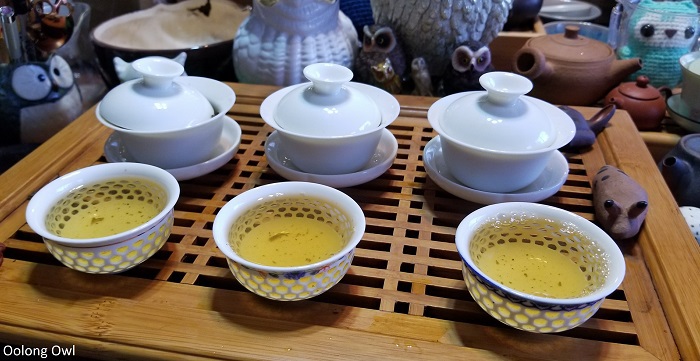
Middle Gaiwan – The hot leaf is vegetal and pungent mind crushing scented.
Middle Gaiwan sheng tastes really subtle, but all in the texture of slick. Pushed, the flavor is pretty neutral vegetal but chewy. I feel like a cow drinking this, the body has a chew to it from within the cheeks from the astringency. The aftertaste is softly fruity like underripe papaya. I like the heaviness of the vegetal taste. It’s like stewed leaves but lightens to fruit. This tea is kind of like sticky rice steamed and wrapped in leaves, filled with really green fruit.
The final infusions, this one got more bitter than number one. It is bad, strong, crushing bitter and that bitter lingers in the aftertaste. A serious crash and burn here.
This one certainly has a great start and a bigger texture drinker. It has a great contrast early on of notes with the vegetal and fruit and clear notes of flavor than the others. I’ve seen plenty of new to puer drinkers ask for “what puer tastes like something I can identify the flavor of?” and this one would be a good choice, with some side learning of texture. It doesn’t hold up well in later infusions. This one likely would do better at 200F, but you will lose the chewy texture, which I think is one of the strong elements of the tea.

Right Gaiwan – The hot leaf smells like box raisins left in a hot car.
Out of the three puer, this one is the sweetest. It has a perky mineral and light floral taste. Pushed, this tea is smooth, creamy mineral amber and honey. Body is thin and not very exciting as the Middle Gaiwan. Right Gaiwan puer is completely easy going. It is a sheng I’d take to an office if I don’t want to disturb my neighbours with the scent of sheng gut bomb. It’s amber, chill, with low dry and bitterness. Mellow and smooth… and not my tastes at all lately. It’s isn’t particularly exciting, but I would drink this in a tumbler for mindless sheng drinking.
Tried alone with a reset palate, Right Gaiwan does have a good amount of bitterness, but less than the other two. It certainly needing pushing to get a floral and fresh greens aftertaste, but the pay off is great.
I would say this tea is the best starter puer, especially if you are jumping on from jumping greens and green oolongs. It is quite friendly, especially compared to the others, in being less bitter. It is easier to drink from beginning to the end, and likely can take some neglectful gongfu style brewing, maybe even a tumbler or grandpa style.
Owl’s guess
My guess is the Left Gaiwan is Bulang, Middle Gaiwan is Nannuo, and Right Gaiwan is Ailao.
I came to this conclusion for the Left Gaiwan being Bulang since it was the more pungent, bitter, and has an interesting, more complex progression that I associate with Bulang teas. The Right Gaiwan is more floral and softer, it lacks the harness of a Bulang, so it had to be the Ailao. I think Middle is Nannuo because of the classic sticky rice texture I associate with Nannuo sheng puer.
Out of the 3, I like Left the most, Right the least. Middle Gaiwan I enjoyed the texture the most.
DRUM ROLL
Left Gaiwan = Ailao Shan | Middle Gaiwan = Nannuo Shan | Right Gaiwan = Bulang Shan
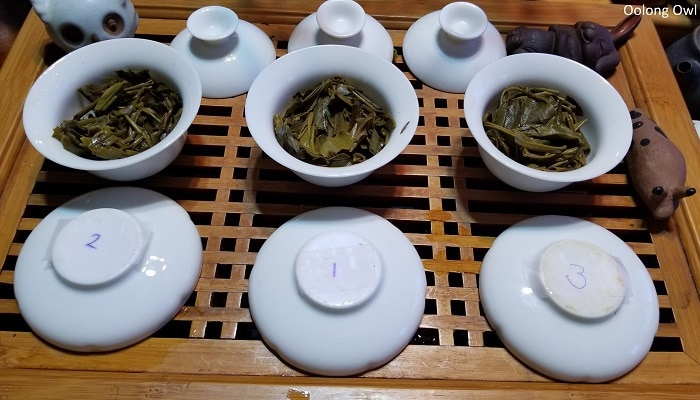
So I got Nannuo right at least. The sticky texture is the give away for me. I screwed up everything else. Or if you want to think about it pessimistically, I got random chance to be correct.
That is a pretty good 2016 Ailao shan then, dang! Good job Everyday Teas! The 2016 Nannuo Shan has that classic texture, which I enjoyed. The Bulang Shan is an approachable tea that would appeal to newer drinkers.
Comments
I know people stress about regions. They make it a determining factor in buying with the preconception of what their favorite region tastes like and appeal. The brain does powerful things to fill in our conceptions on what something should be like. However, tea is a living product. Tea changes with season, processing, storage, age, and environment.
I encourage you all to take a step back and taste the tea, after all, it is what matters the most. It matters more that you enjoy the taste, feel, and experience. Drinking a haute region, bragging rights you shelled $$$ or being exclusive region X doesn’t matter as that is all preconceived notions, ignoring what you are actually experiencing at the moment. In the end, it doesn’t matter what the others think anyway, you are the one drinking the tea.
Thanks again to Everyday Teas for providing the teas. Stay tuned for when I try their 2017 puer!
(tea provided for review)






